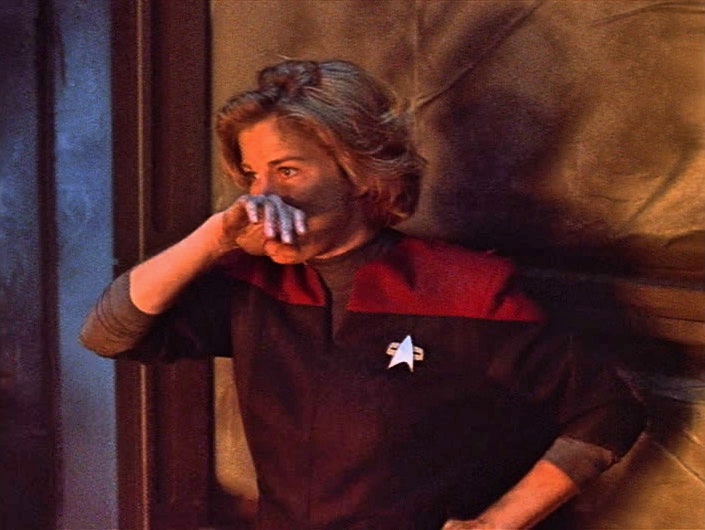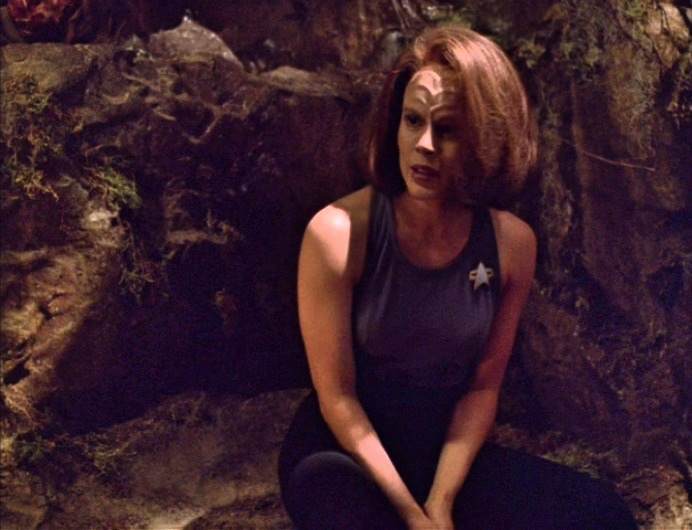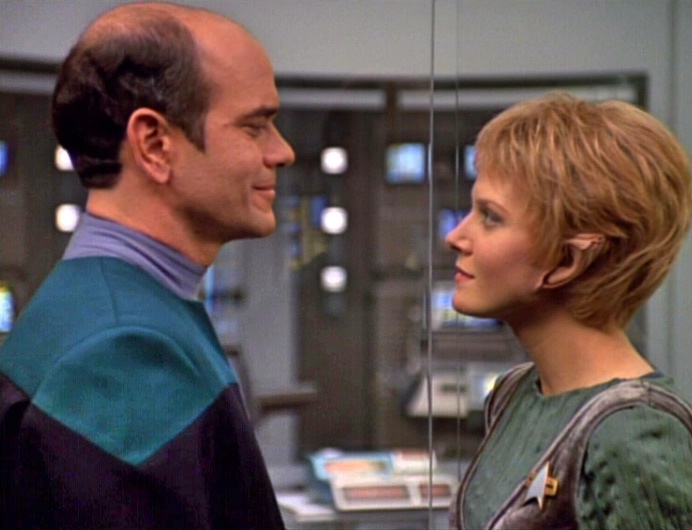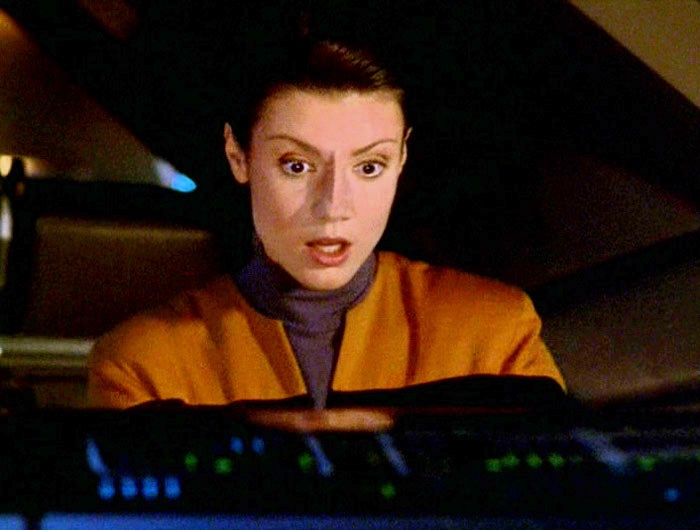 Star Trek: Voyager premiered twenty-five years ago on January 16, 1995 and included three women in the main cast, the most to that point or since. I was barely nineteen, a motherless misfit embarking on a journey of self-discovery in new adulthood, and the women of Voyager helped me grow up.
Star Trek: Voyager premiered twenty-five years ago on January 16, 1995 and included three women in the main cast, the most to that point or since. I was barely nineteen, a motherless misfit embarking on a journey of self-discovery in new adulthood, and the women of Voyager helped me grow up.
Kathryn Janeway taught me to never give up.
At its core, and at its best, Voyager is about adapting, that’s why the story became more cohesive when Seven showed up – but it’s Janeway’s story, too. Janeway’s characterization is messy. It’s the criticism most often leveled at the character and the series: Voyager’s inconsistent writing causes Captain Janeway’s personality and values to veer from one extreme to another. Do Janeway’s personality and values change throughout the course of the series? Sure. She adapts to her situation.
Kathryn Janeway starts out as one kind of captain, based in insatiable curiosity, fierce loyalty, and a secure belief in Federation values. She makes choices based on that foundation and she ends up stranded. So she makes a plan, she moves forward, and she keeps making choices. She makes a plan and then another one, over and over, and moves forward, punches through, over and over, and she gets everyone home. Each plan is created in reference to the current problem, and each choice about which of her values to honor is decided in context to the moment. Captain Janeway’s decisions can be contradictory to each other but they are consistent to her core belief that there is always a way to keep going.

B’Elanna Torres taught me trauma is lasting but it doesn’t define you.
In contrast to Janeway, I find B’Elanna’s character arc through the series to be one of the most consistent and successful in all of Star Trek. She blossoms on Voyager, going from an angry and isolated outlaw to a confident leader with a family and a community. But it’s not easy, even in season seven. Her anxiety and insecurity and fears of abandonment never go away – she learns how to manage them.
This lesson is so important. Everyone struggles with something to varying degrees and there are no easy fixes. Recovery takes time and is full of stops and starts, relapses and pitfalls. B’Elanna learns how to give herself a break, how to ask for help, how to set boundaries, and how to push through the bad times and celebrate the good.

Kes taught me compassion changes minds.
Kes is ill-defined and her potential is never realized. But she makes one huge impact in her three seasons: she is responsible for The Doctor’s personhood. Kes considers The Doctor an individual from the beginning and befriends him as easily as she does the rest of the crew. But Kes not only encourages The Doctor to build his identity, she speaks up for him to everyone else. Kes defaults to compassion and respect and The Doctor and Voyager – as well as Neelix, Tom, and Tuvok – are better for it.

Tal Celes taught me you don’t have to be the best to have worth.
I don’t belong in Starfleet. I’m not officer material, my degrees are in dance and sociology, and I consistently empathize with the “bad guys”. I’d never make it on the Enterprise and I’d barely make it on Voyager. But that’s okay. It’s a big universe and there’s room enough for everybody.
Tal Celes (“Good Shepherd”) believed in Starfleet’s brand of American exceptionalism and it harmed her self-confidence. But with a little push from Janeway she decides good enough is good enough. Extraordinary intellect is not the only path to greatness and it is certainly not the only path to validity.

Rain Robinson taught me to keep looking up.
Billions of words have been written about how Star Trek changed the world. It inspired innovation in technology, engineering and medicine. It built the concept of fandom from the ground up. And it provided a positive vision of the future, one many cling to as we shuffle through WWIII trending on twitter two days into the new year. Read through the blog posts here at Women at Warp to get a taste of all the ways Star Trek changed real people’s real lives.
Rain Robinson (“Future’s End”) is smart and spirited. She’s underappreciated at her boring job working for a sexist, capitalist jerk pretending to be a visionary and after the two most exciting, if dangerous, days of her life, she’s left behind to a life that really can’t ever match up. This is all very relatable to me.
We don’t find out what happens to Rain after Voyager leaves. We don’t know how her timeline shifts; what, if anything, she remembers or if she’s still working in the observatory, still watching the skies. All we know is she once looked up, and she met an alien and she helped save the future and she got to live in Star Trek for two days. And that makes me smile, that gives me hope.

Seven of Nine taught me to write my own story.
I lost my parents at a young age and struggled with anxiety and questions of identity. As a teen I wanted to be assimilated by the Borg, I thought it sounded amazing to lose all my overwhelming emotions and gain a sense of purpose and belonging. It didn’t matter that I would lose myself, too, because I didn’t know who I was, or who I wanted to be. So I latched on to Seven immediately. Here was someone who wasn’t afraid of the Borg, who understood their allure, their strength, and who needed to learn how to find it within herself, and through relationships with other people. Who needed to build her own identity separate from the Collective, and reconcile her childhood trauma, her loss of family and identity.
Captain Janeway gave me someone to look up to, a role model, but I saw myself in Seven. During Voyager‘s run I was in a terrible place emotionally and mentally, at times barely functional, and was briefly hospitalized. Seven of Nine helped me through it. Her story provided a blueprint for how to write mine. I started calling myself Anika (Annika) and eventually legally changed my name. I burst into tears when Jeri Ryan appeared in the Picard trailer, still a survivor, still showing me how to save and create myself. I can’t wait for the future and I am so grateful for the past.
Thank you for this. I heartily agree.
[“Janeway’s characterization is messy.”]
No, it’s not. And I tell you why. Her characterization is about adaptation even more so than Seven’s. Being the lone Starfleet captain in the Delta Quadrant (before she knew about the Equinox) forced her to undergo phases in her role as a starship captain. During Seasons One and Two, she tried to adhere – perhaps a bit too strictly to Starfleet and Federation principles. This may have been fine, but it made her a bit narrow-minded in some ways. Because of the setback in “Alliance”, Janeway seemed more than ever determined to adhere to Starfleet principles, until Seska and the Kazons took Voyager.
After “Basic – Parts I and II”, Janeway decided to be more flexible. Unfortunately, she went from one extreme to another. She then made the same mistake that the Federation did with the Dominion and the Gamma Quadrant in “Deep Space Nine” by trespassing into the territory of an alien race known as “the Swarm” because it would cut off Voyager’s journey by a year or two. Tuvok had advised against violating the Swarm’s space, but she ignored his advice . . . and Voyager nearly got stomped. She made an even bigger mistake by forming an alliance with the Borg to deal with Species 8472. She did this without knowing the full details of the conflict between the two alien races. Her actions led to the Borg’s destruction of a good number of other worlds and the defeat of Species 8472, which had been defending itself against the Borg’s attempted invasion.
She spent most of Season Five in a state of chaos, due to her earlier slide into depression during Voyager’s trip through a void after Season Four and in Season Five’s premiere episode. This led to Voyager’s encounter with the Equinox near the end of the season, the discovery that the other crew were killing an alien species to create enough fuel to get back to the Alpha Quadrant and eventual betrayal of Janeway’s crew. This also led to Janeway reacting emotionally aggressive against the Equinox crew . . . to the point that she nearly tortured one crew member in order to retrieve a kidnapped Seven.
But after adhering too closely to Starfleet principles in Seasons One and Two, veering a bit too far from those principles in Seasons Three and Four; and being in a state of chaos in Season Five; Janeway finally began to learn to balance the unusual aspects of her command during Seasons Six and Seven . . . so much so that during those two seasons, she began to resemble more of a diplomat/head of state, instead of a mere Starfleet captain.